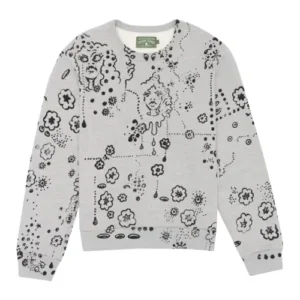Why Denim Tears Matters in the Fashion Industry Today

In an era where fashion often prioritizes aesthetics over meaning, Denim Tears stands out as a brand that challenges the status quo. Founded in 2019 by Tremaine Emory, the label has quickly become a vital force in contemporary fashion—not because it chases trends, but because it creates space for truth, history, and identity in an industry that too often ignores them. Denim Tears matters because it refuses to separate fashion from context, or creativity from culture.
Here’s why the brand holds such significance in today’s fashion landscape.
1. Centering Black History Without Compromise
While many brands have dabbled in performative activism, especially in the wake of global protests against racial injustice, Denim Tears goes deeper. It doesn’t treat Black history as a theme or seasonal inspiration—it anchors its entire identity in the lived experience of the Black diaspora.
From the cotton wreath motif to the reference-laden denim pieces, Tremaine Emory uses clothing to address legacies of slavery, systemic oppression, and cultural resilience. Every drop acts as an educational artifact, a reminder that the fashion industry—and much of Western capitalism—is built on the unpaid labor and creativity of Black people.
In doing so, Denim Tears doesn’t just acknowledge history; it forces the fashion industry to reckon with it.
2. Challenging the Norms of Collaboration
In a market overrun with logo-heavy, marketing-first collaborations, Denim Tears Clothing offers something radically different: message-driven partnerships. Emory’s collaborations with Levi’s, Converse, Dior, and UGG are not about cashing in—they’re about amplifying Black voices in historically white spaces.
The Levi’s x Denim Tears collection, for example, wasn’t just a nod to Americana—it was a reworking of its roots. By adorning denim with cotton wreaths, Emory reminded consumers that even this most iconic American fabric carries the weight of a painful past. These collaborations expand what fashion can be: not just stylish, but socially and historically conscious.
3. Merging Fashion with Cultural Critique
Denim Tears doesn’t simply make clothes—it makes statements. The brand functions as a form of cultural critique, drawing from art, music, literature, and history to dissect how Black people are seen, represented, and commodified. Emory, who has also served as Creative Director at Supreme, brings a curator’s eye to his work, ensuring that each garment speaks to something bigger than itself.
This ability to blend fashion with intellectual depth and emotional weight positions Denim Tears as part of a broader movement—one where fashion becomes a site of protest, education, and empowerment.
4. Empowering Future Generations of Designers
Tremaine Emory’s success with Denim Tears also sends a powerful message to young, independent designers—especially those from marginalized backgrounds: you don’t have to water down your story to be heard. Denim Tears thrives precisely because it is specific, personal, and unafraid. It proves that fashion consumers are not only ready for meaning-driven design—they’re hungry for it.
In that way, the brand doesn’t just impact the runway or the street—it reshapes what is possible in the industry.
5. Preserving Memory in a Fast-Fashion Age
In a world obsessed with speed and disposability, Denim Tears takes the opposite route: slowness, reflection, and care. Every collection is released with intent, often accompanied by essays, photography, and references that add depth. Emory treats fashion like a living archive, where stories are stitched and preserved rather than thrown away.
This approach is not only refreshing—it’s essential. It reminds the fashion world that clothing can carry memory, act as testimony, and serve as a medium for justice.
Conclusion: A Necessary Voice in Fashion’s Future
Denim Tears matters because it doesn’t ask for permission to tell the truth. It stands at the crossroads of art, fashion, and social justice, using every piece as a provocation, a lesson, or a tribute. In doing so, it expands the definition of what fashion can be—not just an industry, but a platform for healing, resistance, and cultural preservation.
- Art
- Causes
- Crafts
- Dance
- Drinks
- Film
- Fitness
- Food
- Jogos
- Gardening
- Health
- Início
- Literature
- Music
- Networking
- Outro
- Party
- Religion
- Shopping
- Sports
- Theater
- Wellness


